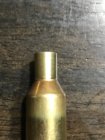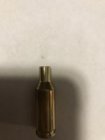Install the app
How to install the app on iOS
Follow along with the video below to see how to install our site as a web app on your home screen.
Note: This feature may not be available in some browsers.
You are using an out of date browser. It may not display this or other websites correctly.
You should upgrade or use an alternative browser.
You should upgrade or use an alternative browser.
Neck turning before fireforming- how far?
- Thread starter Drolds72
- Start date
First make sure that your cutter has the right angle to start cutting into the shoulder area. I use the 21st Century neck turning lathe and a 30 deg. cutter to match the 30 shoulder on my 6XC brass. Cutting into the shoulder area will reduce or eliminate donuts forming.
http://www.xxicsi.com/neck-turning-lathe-complete.html
http://www.xxicsi.com/neck-turning-lathe-complete.html
Exactly what I am using. 21st century with 30 deg cutter. Then, I am bumping .0015 so I am getting just the slightest crush feel on bolt close with an empty piece of brass. Guess next step is to seat right at the lands and start fire forming.First make sure that your cutter has the right angle to start cutting into the shoulder area. I use the 21st Century neck turning lathe and a 30 deg. cutter to match the 30 shoulder on my 6XC brass. Cutting into the shoulder area will reduce or eliminate donuts forming.
http://www.xxicsi.com/neck-turning-lathe-complete.html
Good question, I have not thought that far ahead, but I had to turn to be able to chamber the tight neck...@dmoran, I have been curious about this. If you turn before fireforming, do you then need to re-turn your brass after the 3rd or 4th firing as the shoulder has moved into the neck? Is there any logic in fireforming the brass before turning to avoid or dramtically delay a second turning? Thanks
dmoran
Donovan Moran
@David Christian
Typically, by cutting the necks first and to the shoulder junction, eliminates donut/taper issues, because the junction will get fire-formed into the shoulder portion (more so with Improved wildcats, example picture below) of the case. But at the same time, brass does flow forward in all cartridges from repeated cycles, and further clean up passes may be warranted (dependent on the cartridge, chamber clearances, and amount of growth). Myself always perform repeated clean up passes on all cartridges that I neck turn, as they get cycled and the brass flows forward, and see the gains in neck tension consistency by doing so.
An Improved cartridge example (6Dasher)

Typically, by cutting the necks first and to the shoulder junction, eliminates donut/taper issues, because the junction will get fire-formed into the shoulder portion (more so with Improved wildcats, example picture below) of the case. But at the same time, brass does flow forward in all cartridges from repeated cycles, and further clean up passes may be warranted (dependent on the cartridge, chamber clearances, and amount of growth). Myself always perform repeated clean up passes on all cartridges that I neck turn, as they get cycled and the brass flows forward, and see the gains in neck tension consistency by doing so.
An Improved cartridge example (6Dasher)

So in the case of pushing the shoulder forward you would be making the neck section thinner right. I see how you could eliminate ever getting donuts because the shoulder is now neck thickness and the case must be garbage before you ever get that much growth/forward flow.@David Christian
Typically, by cutting the necks first and to the shoulder junction, eliminates donut/taper issues, because the junction will get fire-formed into the shoulder portion (more so with Improved wildcats, example picture below) of the case. But at the same time, brass does flow forward in all cartridges from repeated cycles, and further clean up passes may be warranted (dependent on the cartridge, chamber clearances, and amount of growth). Myself always perform repeated clean up passes on all cartridges that I neck turn, as they get cycled and the brass flows forward, and see the gains in neck tension consistency by doing so.
An Improved cartridge example (6Dasher)
View attachment 1083088
Donovan is the man to listen to. His advice is always spot on!
Ray
Ray
I dont know enough about case design to know if that is a safe way to operate, but empirical evidence seems to say it prevents a problem and people are not blowing up guns so it must be OK.@AJC
That's the perception, and my own experience. But I cant speak to all cartridges and/or scenario's.
Petros284
Site $$ Sponsor
@David Christian
Typically, by cutting the necks first and to the shoulder junction, eliminates donut/taper issues, because the junction will get fire-formed into the shoulder portion (more so with Improved wildcats, example picture below) of the case. But at the same time, brass does flow forward in all cartridges from repeated cycles, and further clean up passes may be warranted (dependent on the cartridge, chamber clearances, and amount of growth). Myself always perform repeated clean up passes on all cartridges that I neck turn, as they get cycled and the brass flows forward, and see the gains in neck tension consistency by doing so.
An Improved cartridge example (6Dasher)
View attachment 1083088
As usual Donavan is spot on! I perform a clean up turn of my Dasher brass after firing as well.
Pete Petros
21st Century Shooting
foxguy
Gold $$ Contributor
As usual Donavan is spot on! I perform a clean up turn of my Dasher brass after firing as well.
Pete Petros
21st Century Shooting
If you are performing a clean up turn after each firing, does the clean up neck turning effect the number of firings are you getting on a piece of brass?
I'm shooting a 6MM BRA and I'm new to turning necks. (6MM BRA .268 neck - Laupa 6MM BR brass turning to .011.)
Thanks
My personal experience having done the 6 Shehane, 6BR long, 6BRA, 6 Dasher, Whew! If you don't cut into the shoulder enough your brass is garbage! I'll agree with everything "dmoran" say's in doing fireform!@David Christian
Typically, by cutting the necks first and to the shoulder junction, eliminates donut/taper issues, because the junction will get fire-formed into the shoulder portion (more so with Improved wildcats, example picture below) of the case. But at the same time, brass does flow forward in all cartridges from repeated cycles, and further clean up passes may be warranted (dependent on the cartridge, chamber clearances, and amount of growth). Myself always perform repeated clean up passes on all cartridges that I neck turn, as they get cycled and the brass flows forward, and see the gains in neck tension consistency by doing so.
An Improved cartridge example (6Dasher)
View attachment 1083088
Petros284
Site $$ Sponsor
If you are performing a clean up turn after each firing, does the clean up neck turning effect the number of firings are you getting on a piece of brass?
I'm shooting a 6MM BRA and I'm new to turning necks. (6MM BRA .268 neck - Laupa 6MM BR brass turning to .011.)
Thanks
I have seen no difference at all since the clean up cut is removing minimal material. As long as you anneal your brass ( I do so every other firing) and run your loads at a moderate node your brass can last many firings. My Lapua Dasher brass has lasted me at least a dozen firings if not more.
Similar threads
- Replies
- 5
- Views
- 1,154
- Replies
- 5
- Views
- 356
Upgrades & Donations
This Forum's expenses are primarily paid by member contributions. You can upgrade your Forum membership in seconds. Gold and Silver members get unlimited FREE classifieds for one year. Gold members can upload custom avatars.

Click Upgrade Membership Button ABOVE to get Gold or Silver Status.
You can also donate any amount, large or small, with the button below. Include your Forum Name in the PayPal Notes field.
To DONATE by CHECK, or make a recurring donation, CLICK HERE to learn how.

Click Upgrade Membership Button ABOVE to get Gold or Silver Status.
You can also donate any amount, large or small, with the button below. Include your Forum Name in the PayPal Notes field.
To DONATE by CHECK, or make a recurring donation, CLICK HERE to learn how.













